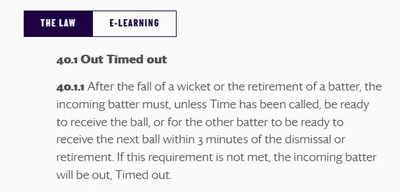The ‘Timed Out’ rule in cricket has garnered attention following Angelo Mathews’ dismissal during the Bangladesh-Sri Lanka ODI World Cup match in Delhi. This rare rule had never been invoked in international cricket until that fateful day when Mathews was declared ‘timed out.’ Here’s a detailed explanation of this rule, shedding light on its nuances:
MCC Law 40.1 (Out – Timed Out)
- Rule 40.1.1: After the fall of a wicket or a batter’s retirement, the incoming batter must be prepared to receive the ball or await the other batter’s readiness to receive the next ball. This should happen within 3 minutes of the previous batter’s dismissal or retirement.
- If the incoming batter fails to meet this requirement, they will be declared ‘Timed Out.’
- Rule 40.1.2: In cases of prolonged delays where no batter assumes the crease, the umpires will follow the procedure specified in Law 16.3 (Umpires awarding a match). The action’s commencement will be considered as the expiration of the 3-minute time limit mentioned above.
Rule 40.2: In the event of a ‘Timed Out’ dismissal, the bowler is not credited with the wicket. This rule parallels run-out dismissals where the fielder executing the run-out does not receive credit for the wicket. Instead, the ‘Timed Out’ dismissal attributes the wicket to the incoming batsman’s failure to reach the crease within the stipulated time limit.
In the specific case of Angelo Mathews, he took more than two minutes to assume his batting position due to issues with his helmet. During this delay, Bangladesh skipper Shakib Al Hasan made an appeal, which the on-field umpire upheld. It’s noteworthy that, according to the ICC World Cup 2023 playing conditions, the time limit for the batter was just two minutes, making Mathews the first cricketer in history to be ‘timed out.’ This unique rule adds an intriguing dimension to the world of cricket, offering a captivating twist to the game when timing becomes a critical factor.

